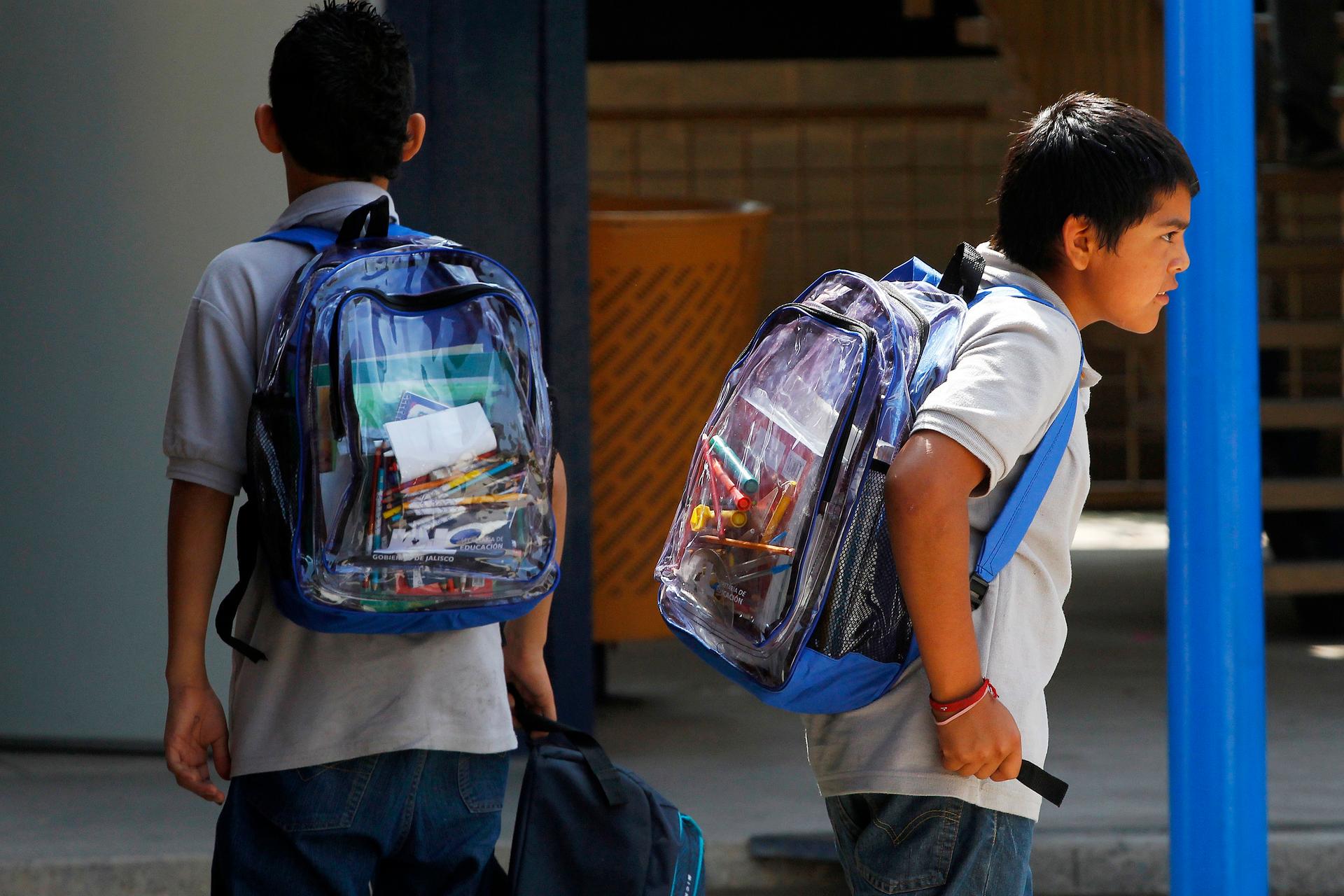In Sandy Hook’s wake, Mexico ponders school safety
High school students carry see-through backpacks in Guadalajara, Mexico, part of a recently introduced “Safe School” program.
MEXICO CITY, Mexico — The video shows a kindergarten teacher calmly taking charge of 16 terrified students, as automatic gunfire erupts nearby.
"Little ones, everyone on the floor," Martha Rivera tells the 5- and 6-year-olds as the guns pop-pop-pop outside. "Nothing is happening. Precious ones, put your faces to the floor. Please don't lift your heads."
Until the shooting stops, Rivera, leader of her school's security committee, coaxes the youngsters into song: "If little drops of rain were chocolate, I would love to be there."
As the children sing, five men lay dead at the targeted taxi stand.
Captured by Rivera herself on a smartphone, the incident last year in the northern industrial city of Monterrey became emblematic of the violence besieging Mexican society and its children.
The video went viral on social media networks.
But it's far from unique.
“There are many teachers who take the same actions" the widely feted Rivera told a radio interviewer. "I've just become their public face.”
Perhaps every nation has its particular way with murder, its peculiar brand of mayhem.
GlobalPost's full coverage: Sandy Hook shooting
Despite Mexico's soaring crime and murder rates, civilian gun ownership is tightly controlled in Mexico. Unhinged loners — at least those without connections to either gangsters or security forces — would have a hard time acquiring weapons for a random Sandy Hook rampage.
Still, massacres — most blamed on outlaws marketing illegal drugs — have drawn many headlines during six years of carnage that's claimed some 70,000 lives, according to a new government tally.
Though rarely if ever directly targeted, Mexico's students, teachers and schools too frequently find themselves in the crossfire.
Young kids have been killed accompanying parents targeted by assassins, or have been hit by stray bullets in street shootouts. Thirteen innocent high schoolers, and the father of one of them, were slaughtered in January 2010 when gang members came gunning for a rival at a house party in Ciudad Juarez, bordering El Paso.
Poverty, immigration and the stress of daily scrounging erode cohesion in many families in the dirt-scratch villages and urban shambles where most of Mexico's children live. Many teens drop out of school — estimates in recent years run as high as 7 million of them — and some frustrated by low-wage work drift into the street gangs that feed foot soldiers to the drug-trafficking cartels.
Bullying — fights, beatings and taunts — define school for many of those who keep studying. Like their US peers, some Mexican children carry drugs and weapons to class.
“There are serious problems here that are not being attended: weapons in the school, drop outs, disintegration of families, drugs being sold near the schools, ” Ramon Villegas, president of the Mexico City-based Parents’ Alliance Associations, told GlobalPost. “We don't know what to do with so much violence, so many assaults, extortions and kidnappings.”
Violence and the violent stalk indiscriminately.
Teachers have gone on strike in the Pacific coast resort of Acapulco and other gangster-plagued cities to demand officials do something about rampant gang extortions.
Rumors of pending gangland attacks prompt panicked parents frequently rushing to pull children from schools in cities bordering Texas, in the port of Veracruz and elsewhere deep into the Mexican interior.
Mothers waiting for their children outside a school have been gunned down in Ciudad Juarez, caught in a battle between gang rivals.
Mexican federal and state officials have responded with Safe Schools programs, instructing teachers and students alike on what to do if gun battles erupt nearby. This includes installing “panic buttons” in classrooms and school offices to alert police of an emergency, and searching kids’ backpacks for drugs and weapons in the schools.
Security has long been heavy at the private schools that tend to most of Mexico's elite and many of its middle class children, who face the greatest risk for kidnappings. Body guards and armored cars are common sights at the priciest schools. Wary parents traditionally trek to meet children at the day's end, even at the shoddiest of urban public schools, which are most exposed to the gangster threat.
But while those measures and the added training have helped in situations like that faced by Martha Rivera, critics like Villegas say truly safe schools remain a distant goal.
“The programs have been around a while but they haven't worked because they don't allow the parents' participation,” Villegas said. “The officials view the parents' place as outside the school doors.”
The attack near Rivera's school — in a working class Monterrey neighborhood 140 miles below the Texas border — echoed a far worse 2009 outrage in the border city of Reynosa. There, gunmen protecting the home of a mid-level gang boss got in a shootout with Mexican troops in the streets flanking a large primary school.
For more than two hours, grenades exploded, and bullets peppered the school's walls and tore through its windows. The school's 20 teachers shoved upturned desks against doors, in hopes of stopping stray bullets. Like Rivera, they struggled to keep nearly 1,000 terrified children lying flat on the floor, their heads down, until the shooting stopped.
None of the children was physically injured. But few came away unscarred.
"I just kept praying that grenades wouldn't explode inside the school grounds," teacher Enrique Morales, 32, said the day after the battle. "I was just thinking of calming the children."
"Many are going to be traumatized," he said. "They're never going to forget."
Our coverage reaches millions each week, but only a small fraction of listeners contribute to sustain our program. We still need 224 more people to donate $100 or $10/monthly to unlock our $67,000 match. Will you help us get there today?
